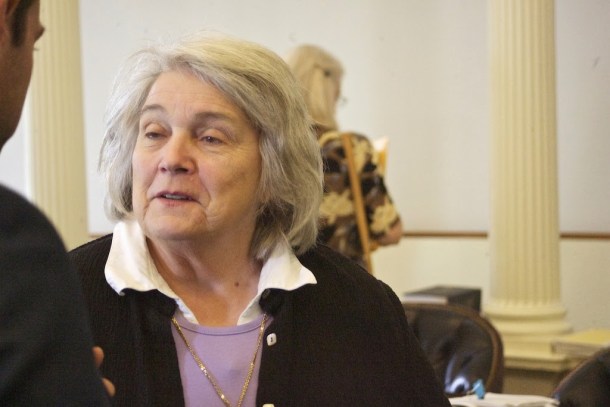
Sen. Virginia Lyons, D-Chittenden, has proposed a bill that would authorize the governor to enter into a regional or nationwide cap-and-trade program to place additional costs on industries that emit greenhouse gases.
The bill, S.66, doesn’t mandate any particular cap-and-trade mechanism. It would require a report by 2019 on the administration’s efforts to enter into a program.
Under cap and trade, regulators set limits on carbon dioxide emissions within a region and sell to businesses the right to emit fractions of that total. Lyons’ bill encourages participation in a program addressing greenhouse gas emissions caused by transportation, heating, cooling and ventilation.
State law already sets a goal of reducing greenhouse gas emissions, both within Vermont and elsewhere if they result from Vermonters’ energy use.
This bill “may not go 2 inches,” but it may lead to some serious discussions among legislators and members of the administration, Lyons said.
“This is the beginning of a conversation, that’s all,” Lyons said. “There are people outside Vermont and inside Vermont who agree that we need to reduce carbon emissions from our transportation sector and our heating sector, so let’s have that conversation … and see what creative ideas emerge. There’s no jeopardy in doing that.”
Gov. Phil Scott is willing to discuss a cap-and-trade program that includes jurisdictions other than Vermont as long as it improves the economy and makes the state more affordable for families and businesses, said his spokesperson, Rebecca Kelley.
Cap-and-trade programs are one of two common ways that states and countries try to deter carbon dioxide pollution by making it more expensive.
Economists typically prefer the other common pricing scheme, which is a carbon tax. Generally these take the form of taxes on fossil fuels. These taxes are often made to be revenue-neutral, meaning a government reduces other taxes in proportion to the size of the carbon tax.
Scott promised during his campaign to veto any carbon tax.
But Scott has also described cap-and-trade programs as a tax.
As long as the bill leads to a serious effort by legislators and the administration to reduce Vermont’s greenhouse gas pollution, Scott can call it whatever he wants, Lyons said.
“It’s in his hands,” she said. “If they don’t want a tax, it’s not a tax.”
Vermont already participates in a New England cap-and-trade program that applies only to electricity generation, called the Regional Greenhouse Gas Initiative, or RGGI.
Environmental advocates often point to the Regional Greenhouse Gas Initiative as an example of what a successful cap-and-trade program looks like.
The program through 2014 brought Vermont nearly $15 million, in exchange for the state’s promise some years ago not to replace the now-shuttered Vermont Yankee nuclear plant with a fossil fuel-powered generator.
Nearly all of that money goes to Burlington Electric Department and Efficiency Vermont, through which the state operates its two electricity efficiency utilities.
The efficiency investments by BED and Efficiency Vermont that RGGI funded through 2014 are expected to eventually save Vermonters $115 million on their energy bills, according to RGGI’s 2014 proceeds report, issued in September.
By the end of 2014, 4,523 Vermont households and 297 Vermont businesses had received efficiency assistance funded by RGGI. That investment is expected to prevent the emission of 138,859 tons of carbon dioxide, the report says.
One environmental advocate said she welcomes the bill but sees a few areas of concern.
One of those is the administrative complexity that cap-and-trade programs typically involve.
There are simpler ways of putting a price on carbon pollution, such as a carbon tax, said Sandra Levine, senior attorney at the Conservation Law Foundation.
Further, it’s important that a new cap-and-trade program not weaken or replace effective existing programs, she said.
Lyons’ bill would allow up to $300,000 a year for program administrative and enforcement costs. Remaining proceeds would be split between home weatherization and energy-efficiency efforts.
The bill would also tighten a requirement in state law that Vermont must cut its greenhouse gas emissions 25 percent from 1990 levels by the year 2028 and 75 percent by 2050 “if practicable using reasonable efforts.”
The bill would eliminate the “if practicable using reasonable efforts” provision.

